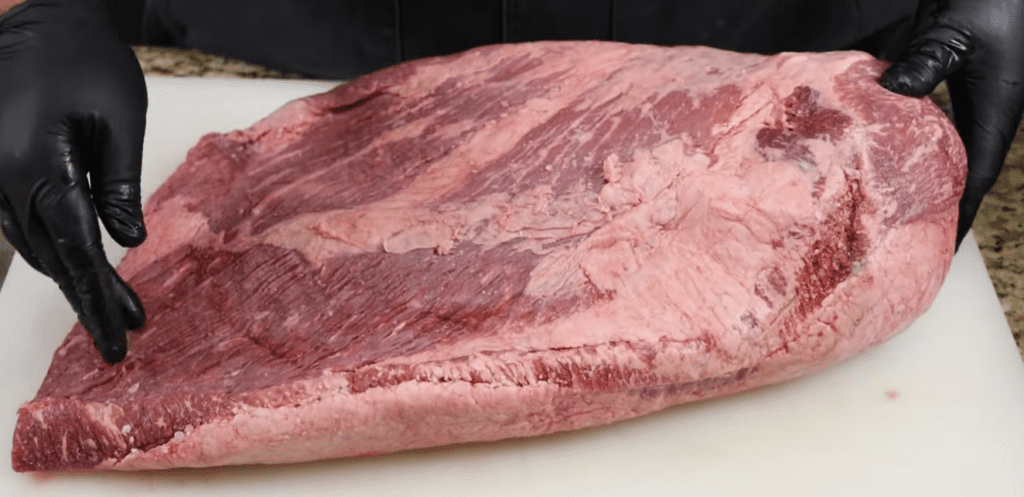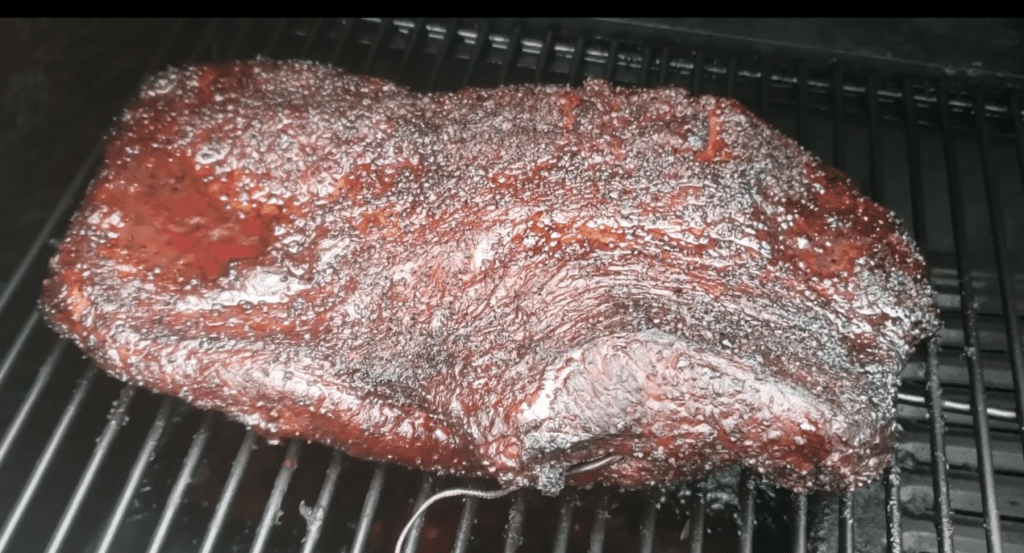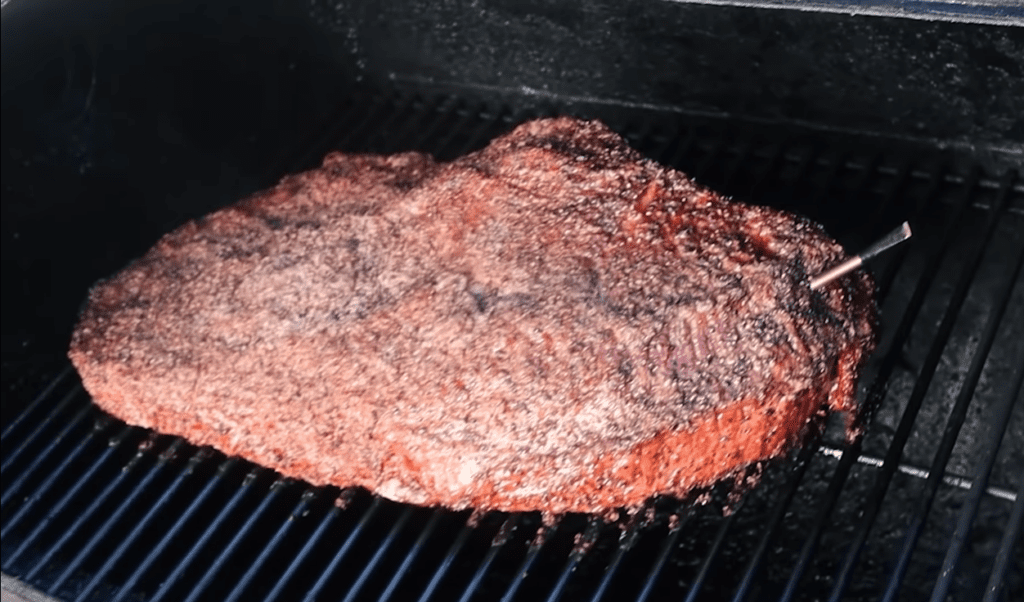The brisket internal temperature is one of the benchmarks to determine your brisket’s doneness. Unfortunately, as an aspiring brisket cook, you come across dozens of opinions by many pit masters on “what should be brisket’s internal temperature when you pull it off the smoker.”.
Whom should you follow?
You get confused.
Today, in this article, we’ll discuss what are the internal temperature ranges for brisket that you should aim for, and how they affect your final brisket result.
In this regard, we’ve considered many pit masters’ opinions from their tutorials, like Harry Soo the pit master at Diamond Bar, Los Angeles, Jeremy Yoder from Mad Science BBQ, Steve Gow from Smoke Trails BBQ, Matt from Meat Church BBQ, and Joe from Smokin’ Joe’s Pit BBQ.
Why not begin with smoking your best brisket?
Before we get into it, remember,
A perfectly low and slow-cooked brisket is all about how tender it is, and how well you can guess its tenderness before eating it. The internal temperature is only the temperature zone when you should check your brisket for some signs of doneness at that stage.
A Few Words about Brisket’s Parts and their Internal Temperature Difference

A full-packer brisket is a tough piece of meat from a cow’s chest with two muscles: fat and point. The flat muscle is loaded with protein muscle fibers connected through connective tissues.
These connective tissues denature at higher temperatures of around 160 degrees and keep forming gelatine up to 180 degrees. The flat brisket holds temperature longer owing to the thickness and cooks faster.
On the other hand, the point is a brisket fat side in a triangular shape. This fat melts and turns into juices at a lower temperature of 140 degrees; the process continues for hours during slow cooking.
So, the ultimate internal temperature in a beef brisket is different when your goal is to get a full tender brisket, at the end.
Owing to different internal temperatures and the science of slow-cooking meat, you must avoid overcooking ann undercooking the brisket:
Here is only one standard to help you,
The temperature in the thickest part of the brisket: flat should not exceed 210.
2 Internal Temperature Stages Before Pulling the Brisket off the Smoker
Usually, when talking about the brisket’s internal temperature, we mean the temperature when you can stop cooking the brisket anymore and wrap it for resting.
Yet, you must know about the different stages of smoking a brisket at a particular temperature to get a perfectly done brisket. So, below, I summarize each stage.
Brisket Internal Temperature at Stall Stage

When you’re slowly smoking your brisket at any temperature from 200 to 300 degrees Fahrenheit, the first main point is when your brisket stalls and bark settles.
This is the temperature zone between 150-175 degrees when the brisket’s temperature stops rising for a few hours and the brisket stalls.
Usually, this temperature zone for stall occurrence is common to observe when you follow a smoke a beef brisket at or above 225 F. However, cooking a brisket on an extra slow temperature stall can happen as early as 125 degrees internal temperature.
During the stall at 165-175 temperature, you take the brisket out of the smoker, do a few tests to check the bark firmness, and wrap it in butcher paper, for re-smoking at a higher temperature.
You can do it by a simple test.
- Push the bark at the fat cap area; if it doesn’t bounce back, the first stage is done. Now, wrapping the brisket in butcher paper or aluminum foil won’t hurt the bark.
- Additionally, it has to be of dark mahogany color, and when you scratch it with the knife’s blunt side, it must sound like cracking on this crunchy bark.
- You see rendered juices pools on the surface.
- You touch the bark and have no loose seasoning on your fingers.
So, just ensure how well the brisket bark has been formed.
Brisket Internal Temperature When Brisket is Done
After wrapping the brisket, you cook it at a higher temperature to break the plateau until it’s butter-like and soft. But when is the brisket so tender?
A simple answer is, that here the temperature zone lies between 195-210F degrees.
Again a defined number for the temperature during this range can be deceiving. For example, if you always pull the brisket off the smoker at an internal temperature of 210F recorded in the brisket’s flat area — many pit masters do it, there is no guarantee that the brisket will not be overcooked.
A hellish chewy brisket will wait for you, and you never want it to happen. In the same way, following some other expert’s advice, if you pull the brisket off the smoker at about 195 degrees Fahrenheit of internal temperature, it can be undercooked — manageable.
What Should be the Best Internal Temperature for a Beef Brisket, Ultimately?
At minimum 195 and maximum 210 in the thickest part of the flat area and anywhere between the range, your brisket will be fully tender and juicy. And other brisket experts like Steve Gow and Joe from Smokin’ Joe’s Pit BBQ only go for the 195-203F range.
Yet, according to Franklin, it’s 203 — I think Steve Gow, Joe, and Jeremey Yoder also follow him. And this mean number is certainly on the safer side — checking the brisket doneness through probe tests still comes first.
If you can recall, in the beginning, I had said that brisket smoking is all about how it feels — the ultimate opinion of Harry Soo, the brisket Champion.
So, as soon as the brisket hits 195 degrees in the flat area, start testing your brisket for doneness if the bamboo skewer slides into it with no resistance, remove it from the smoker, and if not, cook more.
Is 210 F a Good Internal Temperature for Brisket?
If you ask me, my answer is “NO…!”
The only ideal temperature is when your brisket is fully soft inside. I also don’t suggest going so high for the 210 brisket’s internal temperature, for the brisket will keep on rising and cooking inside even after you’ve removed it. So, if you’re a beginner with brisket smoking, going so high can overcook the brisket.
“I have seen pit masters aiming for 210 internal temps for brisket; ” you might wonder.
A few reasons justify their goal of higher internal temperature for a brisket.
- They know their brisket type — pit masters hardly settle to smoke a brisket less than a prime grade.
- They never rest their smoked brisket for a short time of 2 or 4 hours. Instead, they love resting their brisket for a longer period e.g. 8-14 hours.
- Their recipe is specific to their smoker type — and you can’t follow the same recipe for smoking a brisket in a different type of smoker: Weber kettle, Big Green Egg, or a gas grill.
- They prefer to cook large briskets.
In a nutshell, a perfect brisket results from following the best brisket smoking techniques at every stage, which leads to the desired doneness.
Here are special big NOs when you should not go for such a higher temperature, for it’ll result in a hard and dry brisket:
- Your brisket is low grade: Select grade or even lower grade
- You’re cooking only flat brisket
- The brisket is smaller than 14 pounds.
- Your brisket is fairly thin.
To put it simply, if you’re new to smoking brisket, be on the safe side and don’t target the higher internal temperature for your brisket, like 210 degrees Fahrenheit.
Why is 195 Degrees Internal Temperature for a Brisket Good to Consider?
The brisket’s flat, being dense, keeps heat for a long time but shows a temperature lower than the thinner point by 5-8 degrees.
Yet, the point area, when removed from the smoker, loses heat faster, being thin. Hence, when the internal temperature in the flat is 195 F, in the point muscle, it can be around 198-203, and it’s safe to go.
Does it guarantee the brisket doneness?
The answer is, “the doneness tests.” I’ve already mentioned that you have to check your brisket for tenderness, if it passes all tests, you can look forward to resting it.
FAQs
How do you rest a brisket?
When you remove the brisket from the smoker, the internal temperature keeps rising for some time and keeps cooking the brisket.
It’s why, first, rest the brisket at room temperature so that the internal temperature reaches 175-188 degrees. Then, rest it in the cooler for 8 hours.
You can also opt for a lower duration, like 2 hours, and in emergency situations at least 30 minutes. You can know how you can rest your brisket properly here.
How do you monitor the internal temperature of a brisket?

A wireless meat probe thermometer for smokers is the best solution to check the brisket’s internal temperature.
You can insert the probe into the brisket’s thickest area and set an alert for your target temperature. Your thermometer will keep you aware of the temperature.
How do you use an instant meat thermometer to check the internal temperature of a brisket?
To check the brisket’s internal temperature by using an instant meat thermometer, insert the probe into the brisket’s thickest area, and read the temperature.
What is a stall, and how long does it last?
When you cook the brisket, after 5 hours, at a lower internal temperature range, the proteins in the brisket release moisture. This moisture keeps evaporating and prevents the internal temperature from rising for the next few hours.
For brisket, the stall normally starts after 2-3 hours once the internal temperature of the meat is around 150°F. The stall can last for up to 7 hours before the temperature of the meat starts to rise again.
You can’t wait so long, indeed!
Here, the meat smoking experts have come up with a solution known as the “Texas Crutch.”
During the stall, when the brisket’s outer surface gets dense and crunchy, the bark is formed. And wrap the brisket in greased butcher paper or aluminum foil tightly and increase the smoker’s temperature by 20-30 degrees to break that plateau.
What do you do if brisket is left undercooked?
As a beginner with smoking brisket, it’s pretty common to get an undercooked brisket, which is less worrying.
All you need to do is to rest the brisket for a prolonged time without cooling it at room temperature. The brisket will hold its higher internal temperature, and carry-over cooking will help it cook more.
Key Takeaways
- The ideal range of brisket internal temperature for beginners is between 195-203 degrees, but after testing the doneness, you can cook it longer, up to 210 degrees, if it’s less tender.
- Before removing the brisket from the smoker, your brisket must be probe tender and feel like butter resting at room temperature.
- Use two types of probes: a wireless probe thermometer for smokers and an instant meat thermometer so that you get an accurate reading during the course.
universitygrill.net is a participant in the Amazon Associate program and will earn from qualifying purchases.
